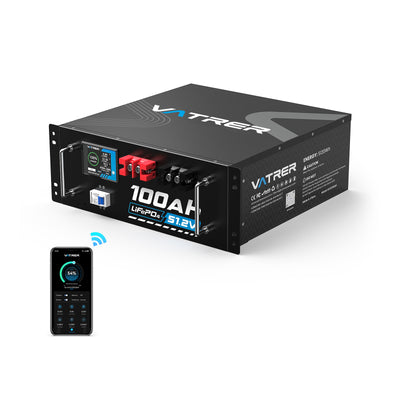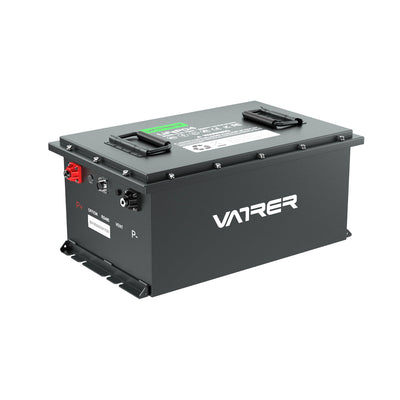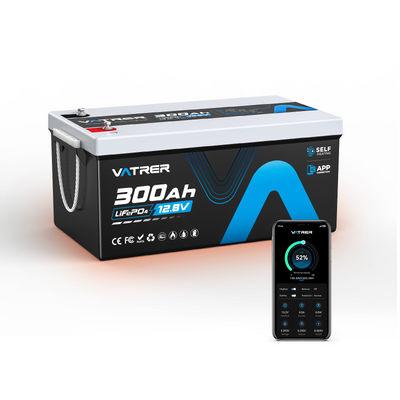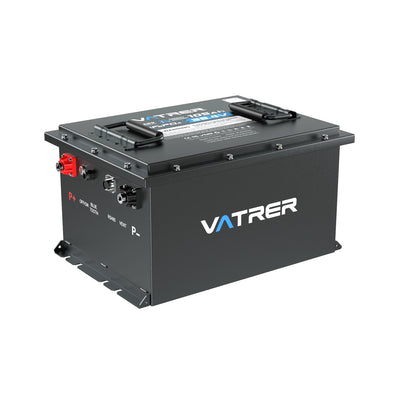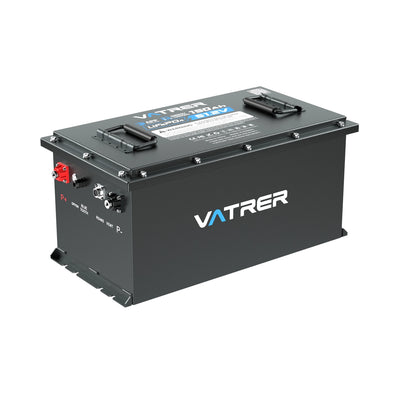
How Many Batteries Does a Golf Cart Take
From the outside, a golf cart looks straightforward, but just about everything that affects how it performs – how far it goes, how quickly it picks up speed, and how much upkeep it needs – comes down to the batteries. Figuring out how many batteries a golf cart takes is about more than just counting what’s under the seat. It means understanding your system voltage, the battery types available, and how each setup affects battery life, range, and long-term costs.
This guide walks you through the essentials so you can confidently identify, maintain, or upgrade the battery setup in your golf cart.

Battery Basics for Golf Carts: Voltage, Setup & Types
The number of batteries in a golf cart depends on three key factors:
- the system voltage (36V, 48V, 72V).
- how the batteries are wired together.
- and the types of batteries you’re using.
System Voltage
Your system voltage dictates how many batteries you need.
A 36V cart needs a battery bank that totals 36V.
A 48V cart needs a combination of batteries that adds up to 48V.
A 72V cart requires a total of 72V.
Battery Types
Golf carts typically rely on two main categories of batteries:
- Lead acid batteries (flooded or AGM): Cost-effective and well proven, but heavier, with a shorter lifespan and more maintenance.
- Lithium batteries: Lighter, essentially maintenance-free in everyday use, with a longer lifespan and more stable power delivery.
The best option depends on the voltage your electric golf cart runs on and how you use the cart day to day.
Here’s a table that summarizes the most common electric golf cart battery configurations, based on system voltage and battery size.
(Note: “batteries for your golf cart” will often depend on both voltage and battery type. Always double-check your cart’s manual or battery tray.)
| System Voltage | Battery Count | Common Configuration | Notes |
|---|---|---|---|
| 36V | 6 batteries | Six 6V batteries | Common in older or light-duty carts. |
| 48V | 4–8 batteries | Four 12V, six 8V, or eight 6V batteries | The most common modern setup. |
| 72V | 6 batteries | Six 12V batteries | Used in high-performance carts. |
| Lithium (48V/72V) | 1 battery pack | Single lithium golf cart battery | Simplifies wiring and maintenance. |
Key point: The number of batteries isn’t random – it’s directly tied to the voltage system. A 48V cart can use different battery counts depending on how the manufacturer set it up (4 × 12V or 6 × 8V, for example).
Switching to a single lithium golf cart battery pack is becoming more common and helps cut down on complexity.
Why Do Golf Carts Use Multiple Batteries?
So why not just run one large battery? Here are the main reasons:
- The electric motor in a golf cart needs relatively high voltage and current. Wiring several smaller batteries in series provides the required voltage without needing one massive battery cell.
- It helps keep weight and upfront costs reasonable and, in lead acid systems, lets you replace individual batteries instead of the entire bank.
- Multiple batteries also make it easier to spread weight under the floor of the cart, which helps with balance and handling.
- As lithium battery technology improves, using a single large pack is more practical, but many carts still use multi-battery setups because of cost and established designs.
Tip: If someone suggests you “just replace one battery” in a series string, be careful. One weak battery can pull down the whole pack and hurt overall performance.
How to Identify Your Golf Cart Battery Setup
Here’s how to figure out how many batteries your golf cart has and what voltage system it’s running:
- Look under the seat or into the battery tray and count how many separate battery units there are.
- On one of the batteries, find the label that shows its voltage rating (6V, 8V, or 12V).
- Multiply that voltage by the number of batteries you counted to get your approximate system voltage.
Example: 6 × 6V batteries = 36V system.
Example: 4 × 12V batteries = 48V system.
- Confirm this with your owner’s manual or the manufacturer’s data plate.
- If you see a single large lithium pack (often labelled “48V” or “72V” with a high Ah rating), it’s likely a lithium upgrade that has replaced the original multi-battery lead acid setup.
With this quick check, you’ll know your basic “battery setup” and be in a better position to speak with suppliers, handle maintenance, or plan an upgrade.
How Golf Cart Battery Count & Voltage Affect Performance
The number of batteries and your system voltage are more than just technical details – they directly affect how your cart behaves on the course or around the neighbourhood:
- More voltage (or a better battery chemistry) generally means more speed and stronger hill-climbing. A 72V system will usually accelerate faster and deal with slopes more easily than a 36V system.
- Range/battery capacity: Higher-voltage systems often support higher capacity or better efficiency, letting you travel farther on a single charge.
- Efficiency & weight: More batteries usually add more weight, which can cut into efficiency unless the system is well optimised.
- Cost trade-off: Systems with more batteries or higher voltage cost more to buy and maintain, but if you use your cart a lot, they can deliver a lower cost per kilometre over time.
So when you think about the “number of batteries,” it’s helpful to think in terms of voltage + capacity + performance, not just how many units are in the tray.
Maintenance Considerations: Fewer Batteries, Fewer Headaches
The number of batteries you run has a big impact on how much maintenance you’ll be doing, especially when comparing older setups to newer ones.
- Lead acid batteries (flooded or AGM) in multi-battery banks: Need regular watering (for flooded types), cleaning of terminals, and careful attention to how they’re charged and discharged. If one battery in the series fails, performance for the whole pack drops. More batteries mean more points where something can go wrong.
- Lithium batteries: In everyday use, they’re basically maintenance-free – no watering, minimal terminal corrosion, and a much longer lifespan. A single large lithium pack can take the place of several individual units, which greatly reduces routine maintenance. For example, the Vatrer 48V 105 Ah golf cart battery supports real-time monitoring, includes a built-in BMS, offers up to 4000+ cycles, and keeps maintenance simple.
Tips: If you’re not a fan of frequent checks or you live somewhere where battery service is inconvenient, a lithium setup is usually the easier long-term option.
Battery Lifespan, Replacement Costs & Long-Term Ownership
Your battery configuration also affects what you’ll spend over the long run.
- Lead acid lifespan: typically shorter, often around 4–6 years
- Lithium lifespan: often 8–10 years or more
- Replacement cost: Replacing six batteries usually costs more than replacing four
- Lithium upgrades: Higher upfront cost, but lower long-term cost thanks to less maintenance and longer service life
A well-designed lithium golf cart battery, such as those from Vatrer, gives you a practical way to cut down on maintenance and extend battery life using high-cycle LiFePO4 chemistry, built-in BMS protection, and stable power output.
Signs It’s Time to Replace Your Cart Battery
All batteries wear out eventually, no matter the type. Watch for these signs:
- Reduced driving range
- Slower acceleration or weak hill-climbing
- Charging takes noticeably longer
- The charge drains faster than it used to
- Battery cases look swollen or show signs of leakage
- Heavy or recurring corrosion on the terminals
Tip: If one lead acid battery in a series bank fails, plan to replace the whole set to avoid imbalance and poor performance.
How to Choose the Right Battery Setup for Your Needs
The ideal battery setup depends on how and where you use your electric golf cart:
- Light or occasional use / flat ground: 36V systems with six 6V batteries are usually sufficient.
- Daily use or mixed terrain: 48V systems give better range, speed, and efficiency.
- Steep terrain, heavy loads, or performance-focused driving: 72V systems or a high-capacity lithium battery are a better fit.
- Lowest maintenance & strongest long-term value: A single Vatrer lithium golf cart battery delivers long cycle life, lower weight, and maintenance-free convenience. Lithium batteries also offer higher usable capacity for the same Ah rating, helping you get more range without adding extra weight.
Conclusion
So, how many batteries does a golf cart take? In most standard lead acid setups, you’ll usually see 4–6 batteries, depending on voltage. But the more important questions are: what system voltage do you actually need, and could a modern lithium pack replace multiple batteries in one go? The number of batteries you run affects speed, range, maintenance, and overall cost.
By understanding your cart’s battery layout, checking both the battery count and system voltage, and choosing the right chemistry (lead acid or lithium), you’ll be setting yourself up for reliable, efficient use.
When you’re ready to upgrade, consider a reputable lithium golf cart battery option, like those offered by Vatrer, which provides longer lifespan, maintenance-free operation, and more consistent performance. Base your choice on how you use your cart in the real world, not just on how many batteries fit in the tray.
FAQs
Can I Mix Different Battery Types or Brands in My Golf Cart?
Mixing battery types or brands in the same pack is almost always a bad idea. Even if the voltage rating matches, different batteries have different internal resistance, capacity, and age-related behaviour. When you string them together in series, the weakest battery limits performance and can end up being overcharged or over-discharged compared with the others.
This applies whether you’re using lead acid or lithium batteries. For the best lifespan and stable performance, always run a matched set: same type, same brand, same age, ideally bought at the same time.
Should I Upgrade from 36V to 48V for My Electric Golf Cart?
Moving from 36V to 48V can improve acceleration, hill-climbing, and in many cases overall efficiency, but it’s not as simple as dropping in new batteries. You’ll need to confirm that your motor, controller, solenoid, and charger are all rated for 48V.
Many people choose to upgrade the entire system at once or use a purpose-built 48V lithium golf cart battery kit that includes the battery, charger, and sometimes wiring guidance. If your cart mainly runs on flat paths at modest speeds, a well-maintained 36V system can still do the job. If you regularly carry heavier loads or drive on hilly terrain, 48V (or higher) makes more sense.
How Do I Choose the Right Battery Capacity (Ah) for My Golf Cart?
Battery capacity, usually listed in amp-hours (Ah), indicates how much energy your cart’s battery can store. A higher Ah rating means more range, but it also means higher cost and, for lead acid batteries, more weight.
Start by estimating how many kilometres or hours of driving you want between charges, then consider how much current your cart typically draws. If you regularly play long rounds or use your cart for neighbourhood commuting, it can be worth choosing a higher-capacity lithium battery so you’re not stuck doing mid-day charging. With lithium, you also get more usable capacity from the same Ah rating, since the voltage stays higher through most of the discharge compared with lead acid batteries.
Do I Need a New Charger If I Switch to a Lithium Golf Cart Battery?
Yes, in most cases you do. A charger built for lead acid batteries uses a different charging profile and may not fully charge, or could even damage, a lithium battery. Lithium batteries need a charger that matches their chemistry and recommended charge voltage. Many modern lithium packs, including those from Vatrer, come with or are compatible with dedicated lithium chargers that work properly with the built-in BMS (Battery Management System). Using the right charger helps protect your investment and lets the lithium battery reach its expected longer lifespan.
How Should I Store My Golf Cart Batteries During the Off-Season?
For lead acid batteries, the main priorities are to store them fully charged in a cool, dry place and either keep them on a maintenance/float charger or top them up every few weeks to avoid sulphation.
Never leave a lead acid pack sitting in a discharged state for months. Lithium batteries are more forgiving, but still benefit from proper storage: they’re best stored at a partial charge (around 40–60%) and disconnected from any unnecessary loads. If you’re using a single lithium golf cart battery, follow the manufacturer’s storage recommendations. Brands like Vatrer provide clear instructions to help minimise capacity loss while the cart is parked for extended periods.
Is a Single Lithium Battery Pack Safe for My Golf Cart?
A single lithium pack that’s purpose-built for golf carts is generally very safe, as long as it includes a solid BMS and you install it according to the manufacturer’s guidelines. The BMS continuously monitors voltage, current, and temperature, and protects against overcharge, over-discharge, and short circuits.
Compared with multiple flooded lead acid batteries, a sealed lithium pack reduces risks like acid spills and hydrogen gas release while charging. Choosing a reputable brand with clear specifications and safety certifications, such as Vatrer, adds extra peace of mind that the pack is designed specifically for traction use in an electric golf cart.
What Are the Main Benefits of Choosing a Vatrer Lithium Golf Cart Battery?
A Vatrer lithium golf cart battery is designed to replace a multi-battery lead acid bank with a single, integrated solution that offers long cycle life, consistent power, and much less daily maintenance.
Compared with a traditional cart battery bank, you get a lighter system, quicker charging, and more even performance across the discharge, so you’re less likely to feel the cart getting “sluggish” near the end of a round. The built-in BMS handles protection and real-time monitoring, and the extended lifespan helps balance out the higher upfront cost.
For anyone planning to keep their electric golf cart for several seasons and wanting fewer battery-related hassles, this kind of lithium setup provides a clear and practical upgrade path.
Share


































